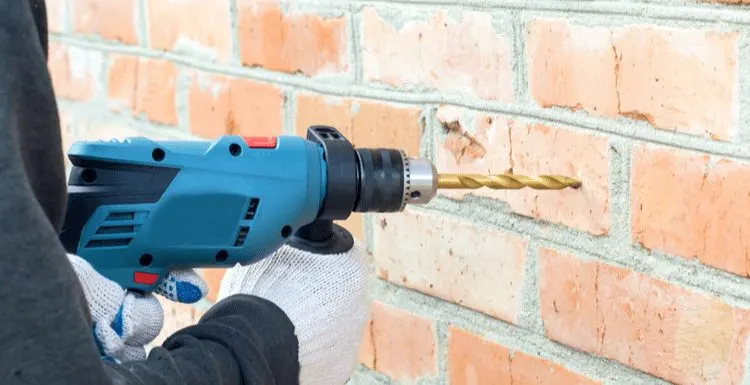Drilling into brick isn’t a skill that most homeowners have. After all, how often do you need to do it? That’s why we’ve made a complete guide to show you the steps to take to successfully drill into brick.
We partnered with Networx to save you big money on your next home renovation project. And quotes are free!
Whether you’re a first-time DIY remodeler or a seasoned hand at fixing it up yourself, it’s always good to know what to expect when you start a remodeling project.
When drilling into brick, it’s essential to understand the materials and the technique needed before you get started, as brick reacts differently from other materials.
The Basics
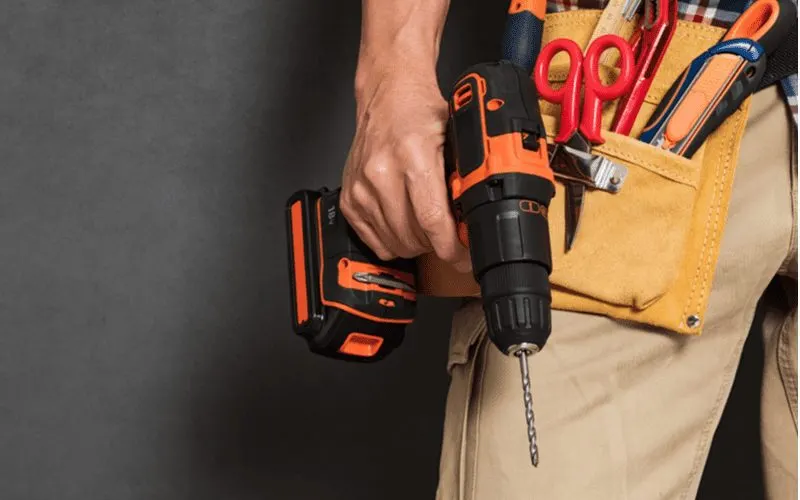
Rido/Shutterstock
Having the right tools and knowing how to use them is essential to getting a good drill hole into a brick. We will go over the following:
- Preparing the work area
- Required safety gear
- Necessary tools
- Proper drilling technique for brick
Once we’ve gone over the project step by step, we will address some things to consider and answer some frequently asked questions.
Before You Start
Before you begin any brick-drilling project, it’s best to prep your work area, gather all your necessary tools and safety gear, and have a plan for the job. Remember to wear eye protection and an N95 mask.
Brick dust has fine silica particles that can be hazardous to your health. Proper eye protection and a particulate mask will keep the silica from getting into your system.
Preparing the Work Area
Before you begin drilling, cover the floor below and any exposed furniture or other household items with a drop cloth or plastic sheeting. Brick dust is a fine particulate that will get into anything that’s not covered.
It’s also a good idea to have a vacuum cleaner, broom, and dustpan handy. Trust me, cleaning up your mess along the way will save you a lot of time and make your project go quicker overall.
Safety Gear
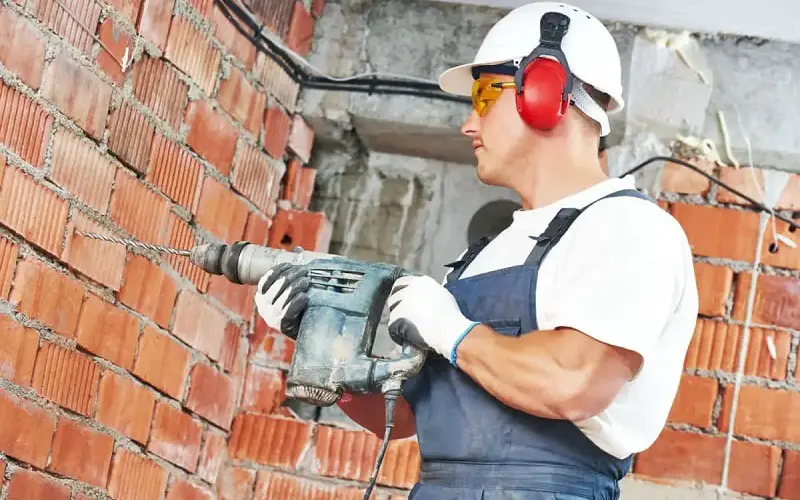
Dmitry Kalinovsky/Shutterstock
Use the following gear to protect yourself:
- Safety glasses
- Ear protection
- N95 or respirator
- Work gloves
Required Tools
It’s crucial that you use the proper tools for the job. Most masonry drilling projects require a hammer drill that will break up the masonry as you drill.
But if your hole is small, less than ½” diameter, then you can get away with a standard rotary drill.
For your project, you’ll need:
- Hammer drill
- Carbide-tipped masonry bit with the desired hole diameter
- A smaller carbide-tipped masonry bit for pilot hole
- Tape measure
- Level if hanging shelving
- Wall anchors
- Masking tape
- Pencil
- Can of compressed air
Proper Drilling Technique
Before you begin, remember that drilling into brick is different from drilling into wood, metal, or other material, and there are some big things to consider. We’ll let the building sheriff explain a few key considerations:
When dealing with masonry, it’s important to remember a few things:
1. Use a Hammer Drill
Brick is very dense, and you’ll need the hammer action of a hammer drill to break up the brick to allow the drill to make its hole. It also keeps you from having to exert too much pressure on the drill, which can result in broken bits and bad holes.
2. Pilot Hole First
Always drill a pilot hole first. If you try to use your bigger bit without a pilot, you run the risk of cracking or chipping the brick, which will compromise the integrity of your wall anchor.
3. Mark the Depth
Make sure you are drilling to the proper width and depth for your anchor, and no more. A hole that’s too deep or of the wrong width will not hold the anchor in place. Use a stop bar on your hammer drill if you have one, or mark the depth on the drill bit with masking tape.
4. Parallel Drilling
It’s of utmost importance to make sure your hole is parallel to the ground. Brick does not have any give, so if the hole is crooked, the anchor will be crooked and will not work correctly.
5. Take Your Time
Don’t force the drill bit. Doing this will lead to cracking and will compromise the bit. Let the hammer action of the hammer driver do the work and apply steady, medium pressure. You want enough to maintain contact, but not so much that you’re exerting force into the hole.
Drilling Into Brick
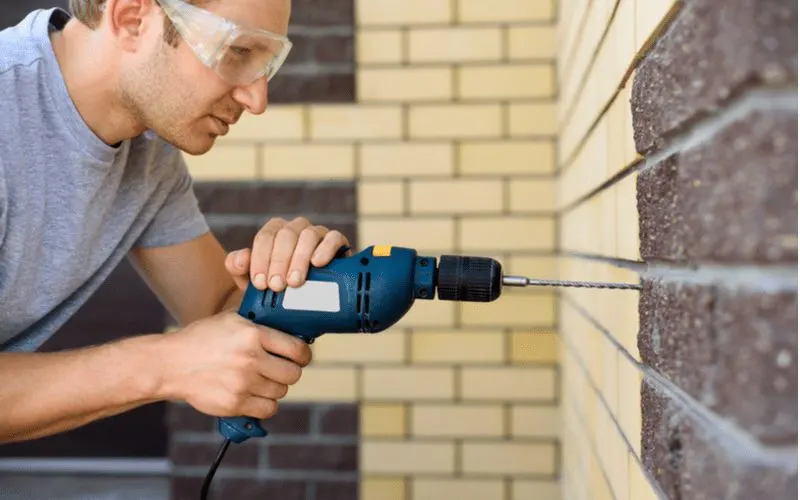
Alexander Penyushkin/Shutterstock
Now that you have everything you need to get started, it’s time to get into how to drill the perfect hole.
- First, mark the spot for your hole by measuring the wall and then marking the area with a pencil. If you are drilling multiple sites, make your marks, then find a piece of wood or other flat board.
- Line up the board and the marks, then use the level to ensure that they are all uniform. If you have a long enough level, you can use that instead of a piece of wood.
- Once you have your spot(s) marked, mark the desired depth on your pilot drill bit with masking tape. Work slowly and methodically with the hammer drill. Do not force the bit.
- Make sure to keep your drill parallel to the ground. Drilling a hole at a skewed angle will result in the anchor not being secure or lined up with its intended use.
- Drill to the depth marked on the bit and no further. If the hole is the wrong depth for the anchor, then the anchor will not have the holding strength it needs and will put undue pressure on the brick. Should you do this, it can cause cracks and failure of the anchor support.
- Once you’ve drilled the pilot hole(s), swap out the pilot bit for your full-size masonry bit. You’ll again want to mark your desired depth on the drill bit to make sure you get the proper depth for the anchor.
- It’s also a good idea before you start your drilling to blow out the pilot hole with some compressed air to clear the path for the hole. Keep your face away from the area you are blowing out so that the dust doesn’t go into your mouth, nose, eyes, or ears.
- When the pilot hole is clear of debris, begin drilling your hole using light, steady pressure. The drill should be working down slowly and steadily.
Once you’ve made the holes, install your anchors and make a final check with the level to ensure that you have a level line for your mounting.
Things to Consider
A few reminders to ensure your project is a success:
- Use a hammer drill for masonry drilling
- Use proper safety gear
- Make sure all holes are level
- Keep hole parallel to the ground for proper anchor purchase
- Work slowly with minimal pressure on the drill
- Use a pilot hole to avoid cracking or chipping
Drilling Into Brick FAQ
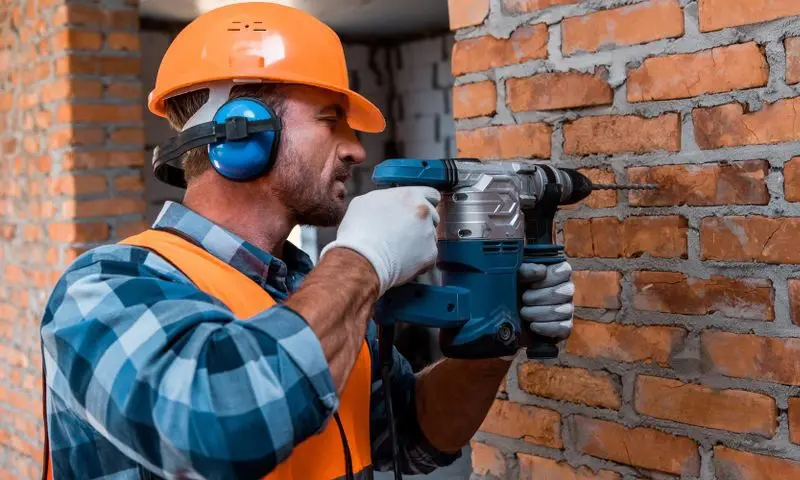
LightField Studios/Shutterstock
Will the brick crack if I drill into it?
If you follow the steps we described above, you have the best chance of not cracking the brick. However, it’s important to note that when drilling into any surface, cracks are possible. All you can do is try to prevent them.
Do I need a special drill bit for drilling into brick?
Yes, you need to use a carbide-tipped masonry bit and a hammer drill to get a good smooth result. Using a cheap steel or aluminum bit will likely cause it to shear off or break.
Can I drill into the masonry instead of the brick?
Masonry is softer than brick, so it’s easier to drill into. However, it doesn’t have the integrity of brick, so using it as an anchor is generally not advisable.
Additionally, making holes in the masonry could loosen the bond between the bricks, causing an unstable surface and compromising the overall integrity of the structure.
We partnered with Networx to save you big money on your next home renovation project. And quotes are free!
So, How Do You Drill Into Brick?
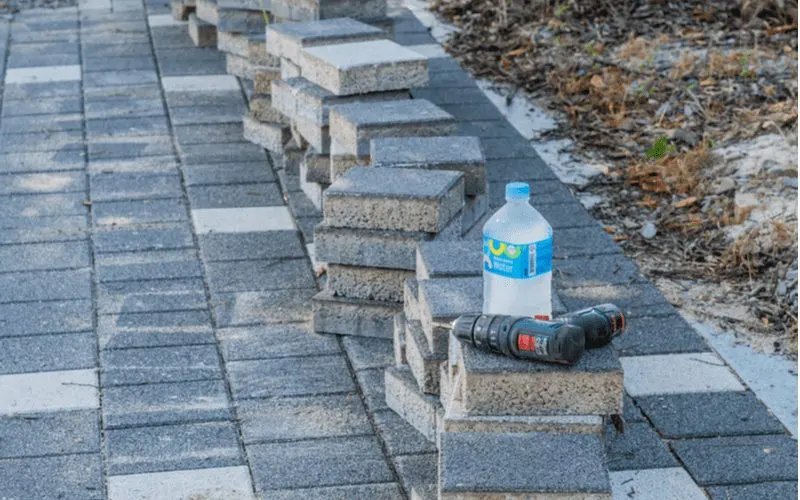
Aminkorea/Shutterstock
Drilling into brick is doable, and you can have a successful result if you follow some simple guidelines. Have the proper tools, prepare your workspace, use your safety equipment, and drill with an appropriate technique.
When you do that, you’ll be working toward a successful outcome for your project. That said, if you’re worried about damaging your home’s structure (as we think you should be), it’s best to call a pro.
And we make it easy to do just that! Simply click the green button above, enter some basic project requirements, and our partner, Networx, will pair you with a local contractor who will give you a completely free estimate. Yes, it’s that easy!

